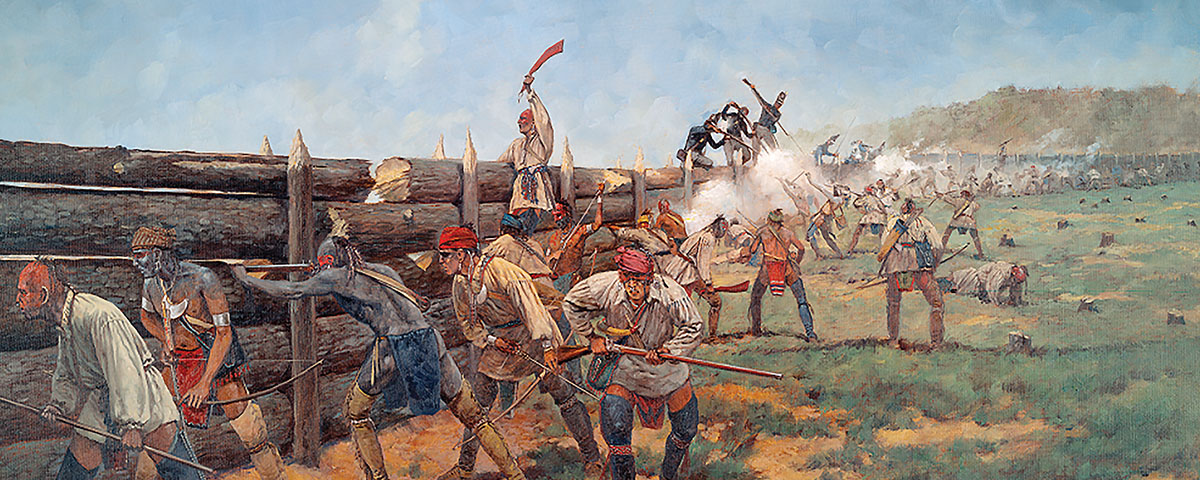In 1812 President James Madison entered the United States into an unpopular war stemming from Europe’s ongoing Napoléonic wars. A year earlier the British had instituted a naval blockade off U.S. ports to choke off trade to France, in the process seizing American ships and impressing U.S. citizens into the Royal Navy. As fighting ensued on the East Coast and along the Canadian border, Maj. Gen. Andrew Jackson of the Tennessee militia emerged as a Southern frontier hero after battling an insurrection of Creek Indians backed by the British and Spanish. The future president’s legendary grit earned him the nickname “Old Hickory” among his soldiers, while Indian opponents knew him less affectionately as “Sharp Knife” and “Pointed Arrow.”
Conflict in the Southern theater of the War of 1812 centered on growing unrest between white settlers and increasingly dispossessed Indians. The focal point was the Creek Nation—one of the recognized “Five Civilized Tribes,” along with the Cherokees, Chickasaws, Choctaws and Seminoles. The Creeks were concentrated along the Coosa, Tallapoosa, Alabama and Chattahoochee rivers of Mississippi Territory (present-day Alabama and Georgia) and had grown dependent on trade with Britain, Spain and the United States. In 1811 Shawnee leader Tecumseh visited the Creeks and encouraged them to resist U.S. encroachment (he did, and two years later he died fighting the Americans in Upper Canada). The eastern group of Lower Creeks ignored such incitement and cooperated with the United States. But on Aug. 30, 1813, renegade Upper Creeks (known as the “Red Sticks,” for their war clubs) stormed Fort Mims on the lower Alabama River, overran its 265-man garrison, massacred more than 250 settlers and Lower Creeks, then destroyed surrounding farms and ranches, killing livestock and destroying crops.
In response Jackson led 2,500 militia troops into Creek territory, defeating the Red Sticks at Tallushatchee and Talladega that November. Encumbered by supply problems and desertions, Jackson didn’t follow up until January 1814, when he drove off superior Creek forces at Emuckfaw and Enotachopo Creek. Resuming his offensive in March, he made straight for the Upper Creeks’ main camp at Horseshoe Bend on the Tallapoosa River. There the Red Sticks—numbering some 1,000 warriors and 350 women and children led by Chief Menawa—had built a 5- to 8-foot-high breastwork of logs across the neck of land enclosed by the river. On March 27 Jackson prepared to launch an all-out assault with his reconstituted force of 2,000 Tennessee militiamen, 700 troops of the U.S. Army’s 39th Infantry, under Col. John Williams, and some 600 Cherokee and Lower Creek allies.
At 6:30 a.m. Jackson divided his army. Brig. Gen. John Coffee led a force of 700 mounted Tennesseans and the allied Indian warriors across the Tallapoosa to surround the village, while Jackson opened a two-hour bombardment with his two cannons and readied the 2,000 remaining men for a frontal assault. Around noon the allied warriors from the adjacent banks used the Red Sticks’ own canoes to cross the river and attack the village from the rear. Noting the small-arms fire, Jackson then sent the regulars of the 39th Infantry on a bayonet charge, led by Williams and accompanied by young Lt. Sam Houston, the future founder of Texas. As the attackers poured across the river and over the Creek breastwork, the battle became a slaughter, as Coffee’s men and Indian allies killed scores of fleeing Red Sticks.
The fighting went on until nightfall. Jackson’s casualties were 49 killed and 154 wounded (many mortally), while his force killed more than 800 Red Stick warriors—557 counted on the field, an estimated 250 shot as they sought to swim the river. Though badly wounded, Menawa managed to flee and remained prominent in Creek society.
Following their defeat at Horseshoe Bend, surviving warriors signed the Treaty of Fort Jackson on Aug. 9, 1814. Under its terms they were forbidden to trade directly with Britain and Spain and forced to cede more than 23 million acres to the United States, virtually half of which comprises present-day Alabama, which joined the Union in 1819.
To commemorate Jackson’s 1814 victory, Congress in 1956 authorized the creation of 2,040-acre Horseshoe Bend National Military Park [nps.gov/hobe], which President Dwight D. Eisenhower signed into being in 1959. Today, the visitor center presents a 23-minute introductory video explaining the battle and its consequences and showcases interpretive exhibits and period artifacts, while visitors can tour the battlefield along the park road.





